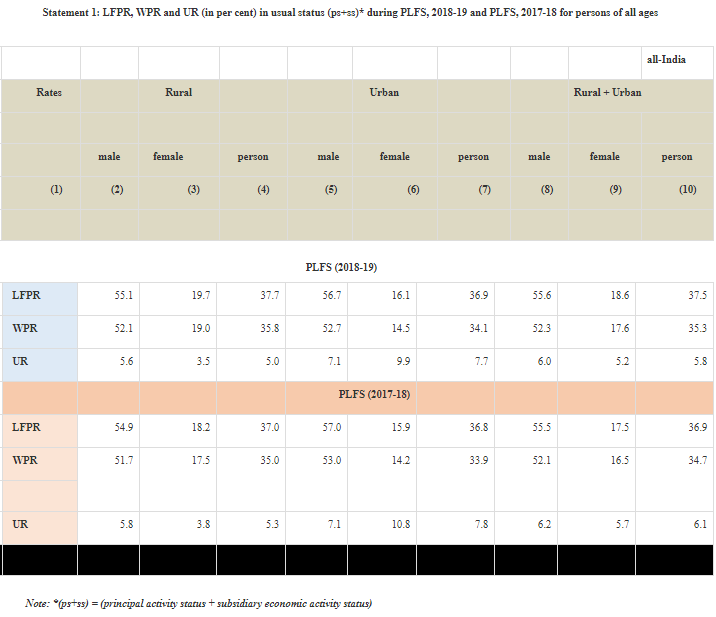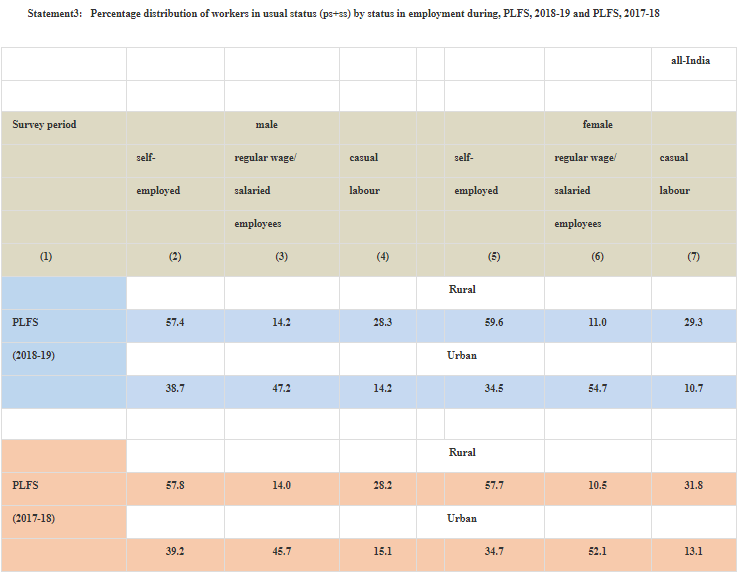Contents
- Periodic Labour Force Survey (PLFS) – Annual Report 2018-19
- TULIP – Urban Learning Internship Program
- World Environment Day
- Global Vaccine Summit 2020
PERIODIC LABOUR FORCE SURVEY (PLFS) – ANNUAL REPORT 2018-19
Focus: GS-III Indian Economy
Why in news?
- Periodic Labour Force Survey (PLFS) – Annual Report July, 2018 – June, 2019 and the Quarterly Report on PLFS, ending June 2019, is released by the National Statistical Office (NSO) on 4th June 2020.
- This is the second Annual Report being brought out by NSO on the basis of Periodic Labour Force Survey conducted during July 2018-June 2019.
Key Findings of PLFS, Annual Report (2018- 2019)


Key Points: Interpretation of the Data (Important)
- India’s unemployment rate improved from the 45-year high of 6.1% in 2017-18 to 5.8% in 2018-19.
- The labour force participation rate also improved marginally, from 36.9% in 2017-18 to 37.5% in 2018-19.
- Women’s unemployment fell from 5.7% to 5.2% – by 0.5%.
- Male unemployment only fell from 6.2% to 6%. – by 0.2% only.
- Urban unemployment is still high at 7.7% dropping just 0.1% from 7.8% in 2017-18.
- Rural unemployment fell from 5.3% to 5%.
- 22% of women in India above 15 were part of the labour force, as against 71.2% men between July 2017 and June 2018.
- Unemployment rate among Schedule Castes (SC) and Schedule Tribes (ST) has gone up during Fiscal Year 2018-19. This is despite overall rate dropping to 5.8 per cent from 6.1 per cent.
- Youth in the age bracket of 15-29 years and educated persons have unemployment rate in the double digits with 17.3 per cent and 11 per cent respectively.
- The worst affected are urban youths with 20.7 per cent unemployment and among urban females it is 25.7 per cent.
Key Employment and Unemployment Indicators
The Periodic Labour Force Survey (PLFS) gives estimates of Key employment and unemployment Indicators like the Labour Force Participation Rates (LFPR), Worker Population Ratio (WPR), Unemployment Rate (UR), etc. These indicators are defined as follows:
Labour Force Participation Rate (LFPR): LFPR is defined as the percentage of persons in labour force (i.e. working or seeking or available for work) in the population.
Worker Population Ratio (WPR): WPR is defined as the percentage of employed persons in the population.
Unemployment Rate (UR): UR is defined as the percentage of persons unemployed among the persons in the labour force.
Activity Status- Usual Status: The activity status of a person is determined on the basis of the activities pursued by the person during the specified reference period. When the activity status is determined on the basis of the reference period of last 365 days preceding the date of survey, it is known as the usual activity status of the person.
Activity Status- Current Weekly Status (CWS): The activity status determined on the basis of a reference period of last 7 days preceding the date of survey is known as the current weekly status (CWS) of the person.
Periodic Labour Force Survey (PLFS)
- National Statistical Office (NSO) launched Periodic Labour Force Survey (PLFS) on April 2017.
- The objective of PLFS is primarily twofold:
- to estimate the key employment and unemployment indicators (viz. Worker Population Ratio, Labour Force Participation Rate, Unemployment Rate) in the short time interval of three months for the urban areas only in the Current Weekly Status (CWS)
- to estimate employment and unemployment indicators in both usual status (ps+ss) and CWS in both rural and urban areas annually.
Sampling Design
- The sampling design remains the same as during 2017-18, that is, a rotational panel sampling design in urban areas. In this rotational panel scheme, each selected household in urban areas is visited four times, in the beginning with First Visit schedule and thrice periodically later with a Revisit schedule.
- For rural areas, samples for a stratum/sub-stratum were drawn randomly in the form of two independent sub-samples.
- In view of these changed sampling designs, the PLFS estimates are not comparable with the results of Employment Unemployment Survey (EUS) of 2011-12 and earlier years.
TULIP – URBAN LEARNING INTERNSHIP PROGRAM
Focus: GS-II Social Justice
Why in news?
An online portal for `The Urban Learning Internship Program (TULIP)’ was launched on June 4th 2020.
The Urban Learning Internship Program (TULIP)
- TULIP is a program for providing internship opportunities to fresh graduates in all Urban Local Bodies (ULBs) and Smart Cities across the country
- TULIP is a program for providing fresh graduates experiential learning opportunities in the urban sector.
- In order to jointly launch the TULIP Program and ensure its proper functioning, a MoU (Memorandum of Understanding) is signed between MoHUA (Ministry of Housing & Urban Affairs) and AICTE (All India Council for Technical Education).
Benefits of TULIP Programme
- TULIP program will help reap the benefits of India’s demographic dividend as it is poised to have the largest working-age population in the world in the coming years. India has a substantial pool of technical graduates for whom exposure to real world project implementation and planning is essential for professional development.
- TULIP would help enhance the value-to-market of India’s graduates and help create a potential talent pool in diverse fields like urban planning, transport engineering, environment, municipal finance etc.
- TULIP would benefit ULBs and smart cities immensely. It will lead to infusion of fresh ideas and energy with engagement of youth in co-creation of solutions for solving India’s urban challenges.
- It would help fulfill twin goals of providing interns with hands-on learning experience as well as infusing fresh energy and ideas in the functioning of India’s ULBs and Smart Cities.
WORLD ENVIRONMENT DAY
Focus: GS-III Environment and Ecology
Why in news?
World Environment Day (WED) is celebrated on 5th June every year.
The 2020 year’s theme is ‘Biodiversity’.
In view of the prevalent situation due to COVID-19 pandemic the Ministry of Environment, Forest & Climate Change (MoEFCC) will be holding virtual celebrations of World Environment Day.
World Environment Day (WED)
- World Environment Day is observed on the 5th of June every year for encouraging worldwide awareness and action to protect our environment.
- Since it began in 1974, the event has become a global platform for public outreach, with participation from over 143 countries annually.
- Each year, WED has provided a new theme that major corporations, NGOs, communities, governments and all celebrities worldwide adopt to advocate environmental causes.
India and the “Biodiversity” theme
- India though having less land mass and more human and cattle population has nearly 8 percent of biodiversity.
- The country is endowed with rich biodiversity hosts 4 of the 35 global bio-diversity hotspots containing several endemic species.
- Biodiversity conservation has traditionally been considered confined to remote forest areas but with increasing urbanization a need has arisen to safeguard and save biodiversity in urban areas also.
Click Here to read more about India State of Forest Report, 2019 with Infographic
GLOBAL VACCINE SUMMIT 2020
Focus: GS-III Science and Technology
Why in news?
India has pledged 15 Million US Dollars to GAVI, the international vaccine alliance, on 4th June 2020, while addressing the virtual Global Vaccine Summit.
What the Prime Minister Highlighted during the Global Vaccine Summit?
- India shared the country’s available stocks of medicines (Hydro chloroquine and others) with over 120 countries.
- Mission Indradhanush aims to ensure full vaccination of the country’s children and pregnant women, including those in the remote parts of the vast nation.
- India has also added six new vaccines to its National Immunization Programme.
- Elaborated that India had digitized its entire vaccine supply line and developed an electronic vaccine intelligence network to monitor the integrity of its cold chain.
- India is also the World’s foremost producer of vaccines and that it is fortunate to contribute to the immunization of about 60 percent of the World’s children.
Global Alliance for Vaccines and Immunizations (GAVI)
- GAVI was created in 2000 as a successor to the Children’s Vaccine Initiative, which had been launched in 1990.
- GAVI is Headquartered in Geneva, Switzerland.
- The GAVI Alliance (formerly the Global Alliance for Vaccines and Immunisation) is a global health partnership of public and private sector organizations dedicated to “immunisation for all”.
- GAVI’s strategy supports its mission to save children’s lives and protect people’s health by increasing access to immunisation in poor countries.
Intensified Mission Indradhanush (IMI) 2.0
- To boost the routine immunization coverage in the country, Government of India has introduced Intensified Mission Indradhanush 2.0 to ensure reaching the unreached with all available vaccines and accelerate the coverage of children and pregnant women in the identified districts and blocks from December 2019-March 2020.
- The IMI 2.0 aims to achieve targets of full immunization coverage in 272 districts in 27 States and at block level (652 blocks) in Uttar Pradesh and Bihar among hard-to-reach and tribal populations.
- With the launch of Intensified Mission Indradhanush 2.0, India has the opportunity to achieve further reductions in deaths among children under five years of age and achieve the Sustainable Development Goal of ending preventable child deaths by 2030.





